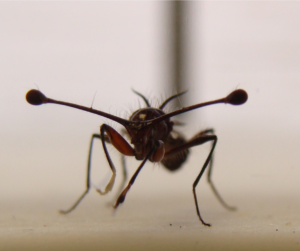
The activities are as follows:
- Teacher Guide
- Student activity, Graph Type A, Level 3
- Student activity, Graph Type B, Level 3
- Student activity, Graph Type C, Level 3
- Grading Rubric
Animals in nature often compete for limited resources, like food, territory, and mates. To compete for these resources, they use aggressive behaviors to battle with others of the same species. Aggressive behaviors are meant to overpower and defeat an opponent. The outcome of a battle depends on many different factors. In insects, one important factor is body size. Larger individuals are usually more aggressive and often win more battles. Chemicals in the brain can also influence who wins a fight. One chemical, called serotonin, can cause insects to have more aggressive behaviors. It is found in the brains of all animals, including humans.
Andrew had always been curious about what makes an animal decide to use aggressive behaviors in battle, or when to end one. He worked with researchers Nathan, Michael, Ken, and John to study the role that chemicals in the brain have on behaviors. The team was interested in how brain chemicals, like serotonin, affect aggression. They have been studying an insect species called stalk-eyed flies. These flies have eyes on the ends of long eyestalks that protrude from their heads. Male stalk-eyed flies use these eyestalks when battling each other. In a previous experiment, they found that serotonin can cause these flies to have more aggressive behaviors. They also knew that flies with shorter eyestalks usually lose fights to larger flies.
This made them curious about whether extra serotonin could make flies with shorter eyestalks act more aggressive and help them win fights against flies with longer eyestalks. The team of researchers discussed what they knew from past research and predicted that if they gave serotonin to short eyestalk flies, it might help them win fights against long eyestalk flies. They thought this made sense because they already knew that serotonin make flies more aggressive, and more aggressive behaviors could help the shorter flies win more fights.

The team designed a lab study to look into this question about the importance of eyestalk length and serotonin for battles in stalk-eyed flies. First, the researchers raised male stalk-eyed flies in the lab. They made sure the flies were around the same age and were raised in a similar lab environment from the time they were born. Then, they measured the eyestalk length for each fly and divided them into two groups. One group had flies with longer eyestalks (Goliaths) and one group had flies with shorter eyestalks (Davids). They took the group of Davids with shorter eyestalks and fed half of them food with a dose of serotonin. This became the treatment group. They fed the other half of the Davids group food, but without serotonin. This was the control group. The treatment group and control group each had 20 flies.
To prepare the flies for battle, all flies were all starved for 12 hours before the competition to increase their motivation to fight over food. The researchers paired each David with a Goliath in a fighting arena. They observed the flies and recorded aggressive behaviors shown by each opponent. The researchers labeled any behavior where the fighting flies touch each other as a “high intensity behavior”. They labeled any behavior where the flies backed away as a “retreat”. Flies that retreated less than their opponent were declared the winners.
Featured scientists: Andrew Bubak, Nathan Rieger, and John Swallow from the University of Colorado, Denver; Michael Watt and Kenneth Renner from the University of South Dakota. Written by: Gabrielle Welsh.
